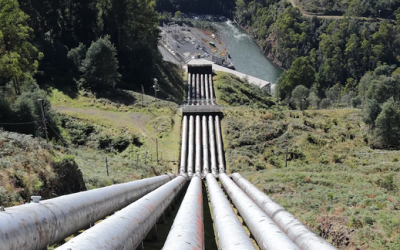Publications
Decarbonization of Blast Furnace Gases Using a Packed Bed of Ca-Cu Solids in a New TRL7 Pilot
Fernandez, J. R., Alonso, M., Mendez, A., Diaz, M., Garcia, R., Cano, M., ... & Abanades, J. C. (2025). Decarbonization of Blast Furnace Gases Using a Packed Bed of Ca-Cu Solids in a New TRL7 Pilot. Energies, 18(3), 675. Access the publication here This work outlines the commissioning and initial experiments from a new pilot plant at Arcelor Mittal Gas Lab (Asturias, Spain) designed to decarbonize up to 300 Nm3/h of blast furnace gas (BFG). This investigation intends to demonstrate for...
DISPLACE post-combustion carbon capture technology – Integration in a steel plant for mitigation of CO2 emissions
Zecca, N., Lücking, L., Chisăliță, D. A., Boon, J., van Dijk, H. A. J., Pieterse, J. A. Z., Giuffrida, A. & Manzolini, G. (2025). DISPLACE Post-Combustion Carbon Capture Technology Integration in a Steel Plant for CO2 Reduction. Journal of Cleaner Production, 144739. Highlights The integration of DISPLACE in a conventional steel mill is investigated. DISPLACE performances have been optimized through several simulations. Aspen Plus has been used to model the integration of...
Establishment of a one-dimensional model for CO2 Pipeline rupture process and design recommendations
Yu, S., Yan, X., He, Y., Chen, L., Yu, J., & Chen, S. (2024). Establishment of a one-dimensional model for CO2 Pipeline rupture process and design recommendations. Energy, 308, 132955. Access the publication here Pipelines serve as a critical means of transporting CO2 within Carbon Capture, Utilization, and Storage (CCUS) technology. Elevated transport pressures may lead to unforeseen pipeline ruptures. To provide practical recommendations for the design of CO2 pipelines and mitigate the...
C4U at the 17th Greenhouse Gas Control Technologies Conference
Once again, the C4U project will be participating in the 17th Greenhouse Gas Control Technologies Conference (GHGT-17), which will take place in Calgary (Canada) on October 20th – 24th 2024.
Investigation of scaling-down experiments for accidental CO2 leakage dispersion risks in constant-pressure transportation pipelines within the CCUS process
Hu, Y., Chen, L., Cao, Z., Yu, S., Yan, X., Chen, S., & Yu, J. (2024). Investigation of scaling-down experiments for accidental CO2 leakage dispersion risks in constant-pressure transportation pipelines within the CCUS process. Process Safety and Environmental Protection, 190, 746-759. Access the publication here Within the framework of strategies to prevent global warming, the safety of CO2 transportation pipelines requires thorough hazard analysis. Accidental leakage during long-distance...
Experimental research on the fracture and arrest process of supercritical CO2 pipelines
Chen, L., Hu, Y., Liu, Z., Yan, X., Yu, S., Ding, J., ... & Chen, S. (2024). Experimental research on the fracture and arrest process of supercritical CO2 pipelines. International Journal of Pressure Vessels and Piping, 212, 105314. Access the publication here As global greenhouse gas emissions become increasingly severe, carbon capture, utilization, and storage (CCUS) technology, as a major approach for achieving carbon peak and carbon neutrality, is attracting growing attention....
Resistance to market interventionism: an analysis of the European industrial carbon management strategy consultation
Määttä, S., Covarrubias, M., & de Gooyert, V. (2025). Resistance to market interventionism: an analysis of the European industrial carbon management strategy consultation. Climate Policy, 25(3), 468-489. Access the publication here Establishing a framework for carbon management in the European Union and aligning this with climate policy relies on collaboration between diverse actors and coordination between diverse goals. The European Industrial Carbon Management Strategy, a policy that...
Building on and contributing to sustainability transitions research with qualitative system dynamics
de Gooyert, V., Awan, A., Gürsan, C., Swennenhuis, F., Janipour, Z., & Gonella, S. (2024). Building on and contributing to sustainability transitions research with qualitative system dynamics. Sustainability Science, 19(6), 1949-1962. Access the publication here This paper explores the novel connection between qualitative system dynamics and sustainability transitions research. As the urgency for sustainable solutions intensifies, this interdisciplinary combination offers a promising...
A probabilistic approach to optimal emergency shutdown valve configuration for pressurised CO2 pipelines
Yi, J., Mahgerefteh, H., & Porter, R. T. (2024). A probabilistic approach to optimal emergency shutdown valve configuration for pressurised CO2 pipelines. Journal of Cleaner Production, 466, 142915. Access the publication here This study presents a multi-objective optimisation technique for determining the optimal number of in-line Emergency Shutdown Valves (ESDVs) for pressurised CO2 pipelines, aiming to balance risk associated with pipeline failure against the valve cost based on...
The C4U Policy Brief Series
Drawing from the interdisciplinary expertise of the C4U Consortium, these briefs highlight how society, business, and policy actors depend on each other for successfully deploying decarbonization technologies such as CCUS in hard-to-abate industrial clusters.
Experimental study of leakage characteristics and risk prediction of N2-containing dense-phase CO2 pipelines in real transportation conditions
Cao, Z., Hu, Y., Chen, L., Yan, X., Yu, S., & Yu, J. (2024). Experimental study of leakage characteristics and risk prediction of N2-containing dense-phase CO2 pipelines in real transportation conditions. Process Safety and Environmental Protection, 187, 1112-1125. Access the publication here In the background of pipelines being widely used as a critical transportation chain for the carbon capture, utilization and storage (CCUS) process, studying the leak diffusion characteristics and...
A new model to predict the small-hole decompression process of long CO2 pipeline
Yu, S., Yan, X., He, Y., Chen, L., Yu, J., & Chen, S. (2024). A new model to predict the small-hole decompression process of long CO2 pipeline. Process Safety and Environmental Protection, 187, 443-458. Access the publication here CO2 pipeline transportation is considered as an economical and safe way of moving large quantities of CO2 in Carbon Capture Utilization and Storage (CCUS) projects. However, design and planning of CO2 pipelines passing through populated areas require careful risk...












